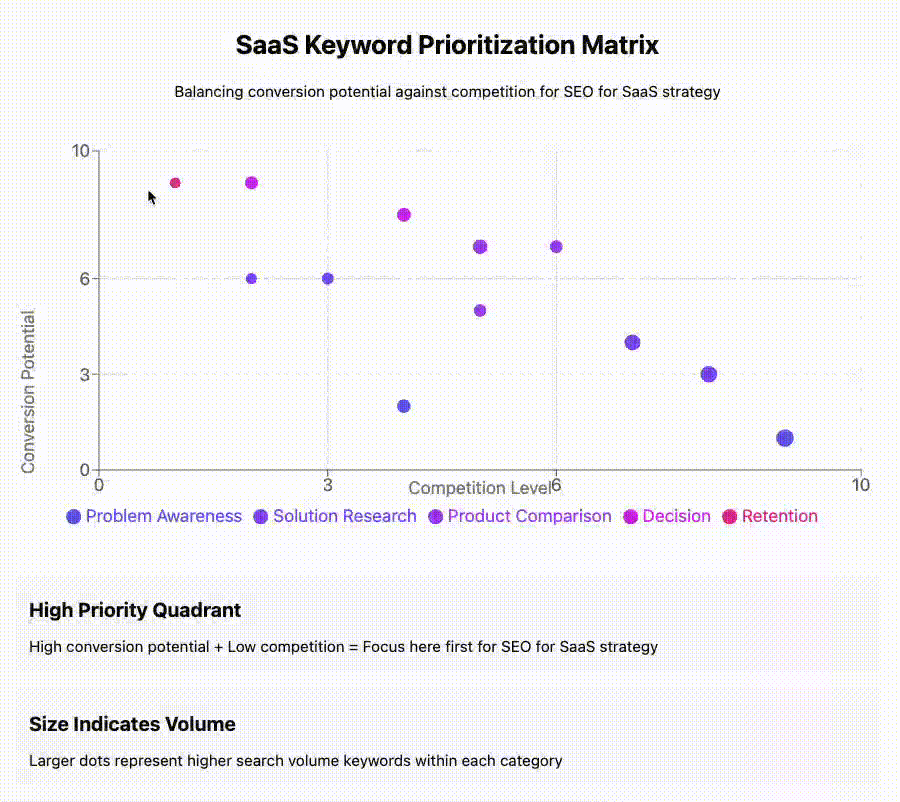I’ve been in SaaS marketing for over a decade now, and if there’s one thing I’ve learned, it’s that getting your product in front of the right audience isn’t just about visibility—it’s about connecting with potential customers at exactly the right moment in their journey. This is where strategic SEO for SaaS becomes not just valuable but essential.
Unlike traditional businesses, SaaS companies face unique challenges in their marketing efforts. Your potential customers aren’t just looking for a product; they’re searching for solutions to specific problems throughout various stages of awareness, consideration, and decision-making.
In this article, I’m going to share my battle-tested methodology for identifying those high-intent keywords that will not only drive traffic to your SaaS website but convert visitors into qualified leads and, ultimately, loyal customers.
Understanding the SaaS Buyer’s Journey
Before diving into keyword research tactics, you need to understand the distinct phases your potential customers go through:
- Problem Awareness Stage: Your prospect recognizes they have a challenge but may not know solutions exist.
- Solution Research Stage: They’re actively looking for ways to solve their problem.
- Product Comparison Stage: They’re evaluating different SaaS solutions against their specific needs.
- Decision Stage: They’re ready to make a purchase but may be looking for final validation.
- Retention Stage: Existing customers looking for support, advanced features, or integration help.

Each stage requires different SEO for SaaS approaches, as the intent behind searches varies dramatically.
The Foundation: Building Your Seed Keyword List
Start by creating a comprehensive list of seed keywords relevant to your SaaS product. These don’t need to be perfect yet—they’re just starting points.
Methods for gathering seed keywords:
- Internal brainstorming: What terms do your sales and support teams hear from customers?
- Competitor analysis: What keywords are your competitors ranking for?
- Industry forums and communities: What terminology are potential users using?
- Customer interviews: How do actual users describe their problems and solutions?
A helpful exercise is to complete these sentence starters:
- “Our software helps users to _____”
- “Our customers struggle with _____”
- “Our solution is an alternative to _____”
- “People use our product when they need to _____”
I remember when working with a project management SaaS startup, we discovered that while we used the term “resource allocation,” our customers were searching for “team workload balancing.” That simple insight completely changed our keyword strategy.

Segmenting Keywords by Buyer Journey Stage
Now, organize your growing keyword list according to the buyer journey stages. This segmentation helps you understand user intent and create content that addresses specific needs.
Problem Awareness Keywords
These often include:
- Question-based queries: “how to improve customer retention”
- Problem statements: “reducing customer churn”
- Pain points: “sales team productivity problems”
Solution Research Keywords
Look for:
- “Solutions for [problem]”
- “[industry] software”
- “Tools for [task]”
- “Ways to improve [metric]”
Product Comparison Keywords
These typically include:
- “[Competitor] alternatives”
- “[Product] vs [Product]”
- “Best [solution category]”
- “[Solution type] comparison”
Decision Stage Keywords
High-intent keywords like:
- “[Product] pricing”
- “[Solution] free trial”
- “[Product] reviews”
- “Buy [solution type]”
Retention Stage Keywords
Existing customers search for:
- “[Product] integration with [tool]”
- “How to use [specific feature]”
- “[Product] API documentation”
- “[Product] advanced features”
This segmentation becomes your strategic roadmap, helping you target the right keywords at the right stages.
Finding High-Intent Keywords Using Advanced Research Methods
Now that you have your keyword foundation, it’s time to dig deeper to identify those high-intent terms that will drive qualified leads.
1. Competitive Intelligence Mining
Your competitors have already done some of the work for you. Use tools like Ahrefs, SEMrush, or SpyFu to analyze:
- Which keywords drive the most traffic to competitors
- Which pages have the highest engagement metrics
- What content types perform best for specific keywords
Look especially for keywords where:
- Competitors rank well but don’t have optimized content
- There’s high search volume but low keyword difficulty
- Commercial intent is strong (contains terms like “buy,” “price,” or “demo”)
I was working with a client last year who discovered that their biggest competitor was ranking #1 for a high-value keyword, but their content was outdated and shallow. We created a comprehensive guide targeting that term and managed to outrank them within three months – sometimes the best opportunities are hiding in plain sight.
2. Customer Intent Mapping
Map specific keywords to customer intent by asking:
- What is the searcher trying to accomplish?
- Where are they in the decision-making process?
- What information do they need right now?
For example:
- “Email marketing software” → General awareness/research phase
- “Mailchimp alternatives for e-commerce” → Comparison phase with specific needs
- “HubSpot CRM free trial” → Decision phase, ready to test
This mapping helps prioritize keywords based on potential conversion value, not just search volume.
3. Long-Tail Keyword Identification
For SaaS companies, long-tail keywords often indicate higher intent and specificity. These might have lower search volume but much higher conversion potential.
Look for:
- Feature-specific terms: “CRM with custom field automation”
- Industry-specific applications: “project management software for architects”
- Problem-specific solutions: “software to track employee training compliance”
4. Search Intent Analysis Tools
Use tools like:
- Google Search Console to see which queries actually bring users to your site
- AnswerThePublic to discover question-based searches
- AlsoAsked.com to understand related questions
- Google’s “People Also Ask” and “Related Searches” for intent patterns
These resources help identify not just keywords themselves but the context and intent behind them.
Prioritizing Keywords by Business Impact
Not all keywords are created equal. The final step is prioritizing your list based on potential business impact.
Create a scoring system that considers:
- Search volume: How many monthly searches does this term get?
- Conversion potential: How likely is someone searching this term to become a lead?
- Competition level: How difficult will it be to rank for this term?
- Resource requirements: How much content/effort will you need to rank?
- Business alignment: How well does this keyword align with your product strengths?
Using a simple 1-5 score for each factor can help you quantify otherwise subjective decisions.
Here’s a basic prioritization formula: Priority Score = (Search Volume × Conversion Potential) ÷ (Competition Level × Resource Requirements) × Business Alignment
This approach ensures you’re not just chasing high-volume keywords but focusing on those with the highest potential return on investment for your SaaS business.
Real-World Impact: SEO for SaaS Success Stories
Let’s look at how this methodology has worked in practice:
Case Study 1: Accounting SaaS Platform
A mid-sized accounting software company implemented this stage-based keyword research approach and saw remarkable results:
- They identified that “bookkeeping automation for small business” had 40% lower competition than general accounting software terms
- Creating comparison content targeting “[Competitor] vs [Their Product]” keywords increased demo signups by 32%
- Focusing on integration-related keywords (“accounting software that works with Shopify”) generated 24% more qualified leads than general brand terms
Their content manager told me, “We wasted a year chasing high-volume keywords before realizing our best conversions came from super-specific terms that directly addressed our ideal customer’s pain points.”
Case Study 2: HR Software Provider
An HR software provider used intent-based keyword research to revamp their content strategy:
- They discovered specific pain point terms like “employee onboarding compliance tracking” converted at 3.5× the rate of general “HR software” terms
- Creating detailed comparison pages targeting alternative searches increased trial signups by 28%
- Long-tail keywords targeting specific industries (“healthcare employee scheduling software”) improved their lead quality score by 45%
Both cases demonstrate the power of targeted, intent-focused keyword research specific to the SaaS buyer journey.
Implementing Your SaaS Keyword Strategy
Once you’ve identified your high-intent keywords, implementation becomes critical. For each target keyword:
- Map to specific content types based on search intent (guides for educational keywords, landing pages for commercial intent, etc.)
- Create a content calendar prioritizing high-impact terms first
- Develop comprehensive content that thoroughly addresses the searcher’s intent
- Optimize for both search engines and conversions with clear CTAs appropriate to the buyer’s journey stage
- Regularly review performance and refine your approach based on actual results
Remember that SEO for SaaS is not a one-time project but an ongoing cycle of research, implementation, measurement, and refinement.
Common Pitfalls in SaaS Keyword Research
As you implement your strategy, watch out for these common mistakes:
- Ignoring customer language: Using your internal terminology instead of how customers actually search
- Prioritizing volume over intent: Chasing high-volume keywords with low conversion potential
- Neglecting bottom-of-funnel terms: Missing high-intent keywords with direct business impact
- Static keyword research: Failing to update your research as market conditions and search trends change
- Overlooking competitive positioning: Not identifying keyword opportunities where you can outperform competitors
I made the mistake of ignoring customer language early in my career. We kept optimizing for “enterprise knowledge management solution” when our customers were searching for “company wiki software.” Don’t make the same mistake I did!
Measuring Success: Beyond Rankings
How do you know if your keyword strategy is working? Look beyond basic rankings to measure:
- Organic traffic by buyer journey stage: Are you attracting visitors at multiple stages?
- Conversion rates by keyword category: Which types of keywords produce the most leads?
- Lead quality by search term: Are certain keywords bringing in better-qualified prospects?
- Customer acquisition cost from organic search: How efficiently is your SEO driving business results?
- Lifetime value of search-acquired customers: Do customers from certain keywords stay longer?
These metrics help tie your SEO for SaaS efforts directly to business outcomes.
Conclusion: The Strategic Advantage of Intent-Based Keyword Research
In the SaaS world, your SEO strategy is only as good as the keywords you target. By focusing on high-intent terms aligned with specific stages of the buyer’s journey, you create a strategic advantage that goes beyond traditional keyword research.
Remember: the goal isn’t to drive just any traffic—it’s to attract the right prospects, at the right moment, with the right content. This focused approach to SEO for SaaS ensures your marketing efforts translate directly into business growth through qualified leads and lasting customer relationships.
I’ve seen companies transform their entire growth trajectory by getting this right. One client went from struggling to hit their lead targets to having more qualified demos than their sales team could handle—all because they stopped chasing vanity keywords and started focusing on high-intent terms that actually drove conversions.
By implementing the methodology outlined in this guide, you’ll build a keyword foundation that supports not just your search visibility, but your entire customer acquisition strategy.


